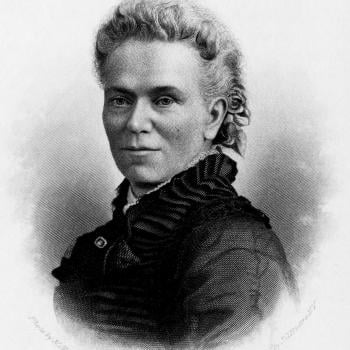Now Featured in the Patheos Book Club
The Core of Johnny Appleseed
The Unknown Story of a Spiritual Trailblazer
By Ray Silverman
What was your first experience of Johnny Appleseed?
I encountered Johnny Appleseed for the first time when I was a child—perhaps in elementary school. Johnny always struck me as a happy-go-lucky sort of person who loved nature and went about doing good for others. I suppose I was influenced by Walt Disney's animated cartoon, Melody Time, which came out in 1948 when I was around four years old.
By the way, the cartoon is available on YouTube under "Melody Time Johnny Appleseed." It is beautifully done, and includes the now-famous song, "The Lord is Good to Me"—written for that film.
How did you get interested in writing a book about him?
Joanna Hill, executive editor at the Swedenborg Foundation, asked me if I would be interested in doing a book about Johnny Appleseed from a Swedenborgian point of view. She was thinking of a book that would be similar to the one I did last year for the Foundation, Helen Keller's How I Would Help the World. I was interested.
But after I began to read the current research on Johnny Appleseed, I was more than interested: I was raring to go! I realized that a new book that saw Johnny from the inside out was absolutely necessary. In fact, I saw that an accurate portrayal of Johnny's Swedenborgian faith could be a touchstone for clearing up inconsistencies, dispelling myths, and giving readers a clearer picture of this remarkable man.
I also saw that Johnny's light-hearted spirit, deep religious interest, and useful life could be a powerful and important model for contemporary readers.
As you were doing the research for this book, what surprised you the most?
My answer may surprise you, but here it is. As a child growing up in the traditional school system, history and geography were my least favorite subjects. To me, they seemed to be little more than memorizing long lists of names, dates, battles, and places. This had very little interest for me.
But when I began to study the story of Johnny Appleseed, history and geography came alive! I began to realize that Johnny's story is inseparable from America's coming of age. Everything became interesting and significant, whether it was the Battle of Bunker Hill in 1775 (Johnny's father fought in it), the Northwest Ordinance of 1787 (it enabled Johnny to expand his apple tree business into Ohio and Indiana), or a petition for a New Church minister in Mansfield, Ohio, in 1822 (organized and signed by Johnny Appleseed).
Similarly, geography came alive. I traveled to many of the places where Johnny had traveled, walked the trails, sat by the rivers, and imagined what Johnny had done in those places. As I crossed the rugged but beautiful Allegheny Mountains, I imagined Johnny and the wagon trains crossing as well.
My most vivid experience was in Franklin, Pennsylvania, the site of one of Johnny's earliest nurseries. There I was, at the confluence of the Allegheny River and French Creek, marveling as I watched the current run swiftly southward toward Pittsburgh. I knew that at one time Johnny had been on that river, perhaps floating downstream on a raft, on a sunny day, reading Swedenborg. And I loved the idea that the swiftly flowing Allegheny River would eventually join the Monongahela to form the powerful Ohio River, which in turn would become the mighty Mississippi, flowing south to the Gulf of Mexico.
Yes, I surprised myself with my newfound love for history and geography!
How much do we really know about John Chapman, and is it difficult to separate the historical facts from the legends about him?
For the most part, the stories about Johnny Appleseed have been handed down from generation to generation in a form of "whisper down the lane." Some say he never married because he was expecting to have two wives in heaven. Others say that he never married because his true love died before they were married and he expected to be together with her again in heaven.
Which story do you go with? How do you know? Since there is no written record of what Johnny actually said about his love life, we cannot know for sure. But when we realize that Johnny was a Swedenborgian with an ardent love for the teachings of the New Church—and this can be documented—it becomes clear that the story about expecting to be reunited with his true love in heaven is more plausible.
Another story involves Johnny's love and respect for nature. It is said that he had such a great reverence for nature that he wouldn't harm a fly or kill a mosquito. On one occasion when mosquitoes were attracted to his campfire and dying in the flames, he put out the fire and slept in the cold rather then see a mosquito die. Johnny had a great respect for nature, but he did not worship it. As a Swedenborgian he worshiped the Creator—not the creation. So, again, seeing Johnny from the inside out—first and foremost as a Swedenborgian—becomes a way of discerning between historical facts and legends. In other words, the story about Johnny saving the mosquitoes is most likely a legend.




